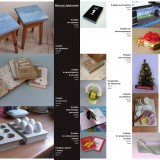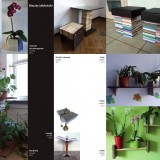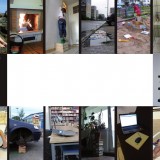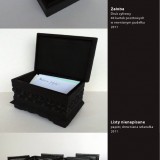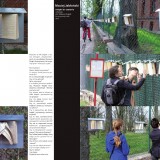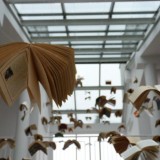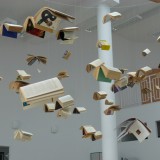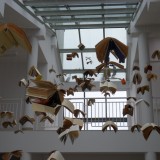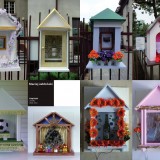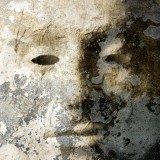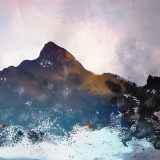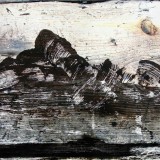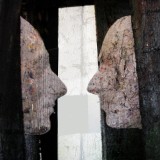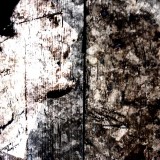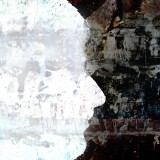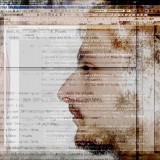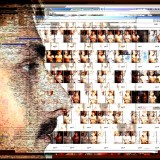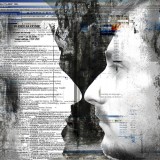Maciej Jablonski
Maciej Jabłoński (born 1974). In 2000 he graduated with honours from the Department of Graphics and Painting and in 2002 from the Department of Visual Education (currently Department of Visual Art), within the Intermedia Studio of the Academy of Fine Arts in Łodź. In 2007 he received a Ph.D. from the Art Institute of the Art Department in Cieszyn of the Silesia University in Katowice. He currently works at the Łodź University of Technology in the Department of Design, where he is a lecturer in sculpture and composition. Jabłoński expresses himself mainly in such media as the art object, artistic book, multimedia and art action. He also works in the field of graphic design.
Jabłoński was already interested in the possibilities of devising an artistic book during his studies. Here he combines both digital technologies and natural materials such as stone, wood, canvas and handmade paper, which he uses in his works to form assemblages existing on the border between a book and an artistic object. His first books focused on nature and the identity of the artist. An example can be seen in Calendar from 2003, a rhythmical composition divided into 12 squares and created using found stones, feathers and dry flowers. In a book entitled Looking At Oneself (2006) he used a processed image of his face. This motif shows up in his art many times. A work, which has a very personal meaning and is entitled Mourning, was created after the death of his wife and commands particular attention. It was awarded third prize in the 9th International Festival of Book Art “Correspondence”. It is a collection of forty ascetic postcards with white captions against a black background.
For a few years Jabłoński in his projects has questioned the contemporary role and character of a book. Despite the drop in reading, a book is still a special object within the social conscience. People still reluctantly throw books away or burn them, although less and less often they are being read. Therefore he created a project entitled Books Not To Read. “I made books that are made to look good on a shelf, can be used in a toilet but also as flower pots or weights. Books to lend, to act as a towel (for someone who comes out of the sauna), a book with balls and without (someone may like to keep their own in it). There is also a book to stuff a woman’s handbag and a book good for nothing, because it can’t be opened. A few of the works from this series went towards recycling design. I made book furniture, for example a pouf, a small table, flower stand, lamp or a shelf.” Jabłoński collects “unwanted” books from his friends and gives them a second life by making something “more useful” out of them. At the same time he deprives them of a fetish feature and reduces them to the rank of a common object.
In 2013 during the Art and Documentation Festival Jabłoński showed a series of photos: Usages that were a part of the Books Not To Read project. On the photos we can see that books may be used as a car lift, a footbridge over a puddle, a cover for one’s private parts on a beach or for one’s face during the process of arrest, or as a palette to mix paints. The artist often makes his interventions with books in a public space. These are ephemeral actions which he then documents. It is a kind of a “performance for photo” (a term used by the Łódź Kaliska group). Jabłoński’s books go through media transitions – a photograph can be the documentation of an action or a photo of an object, however each of them is an autonomous work of art.
In parallel to the project Books Not To Read there emerged an exhibition entitled Books To Read, which was presented in 2012 in the Artistic Book Museum in Łódź. On the Museum’s fence there were placed 49 books covered to protect them against rain and wind by metal shades. Passers-by could browse them through or read. The artist didn’t pick the books according to any specific idea, they were hung there accidentally, just as the passers-by were accidental. The ascetic installation evoked associations with conceptual artworks.
In 2012 he also made an installation entitled Migration, presented in the Education Centre “Glass House” in Ciekoty close to Kielce which is a place related to Stefan Żeromski. The artist hung a few hundred books in a spacious hall covered by a glass roof. They seemed to levitate in the air. To quote the artist: Books migrate there for winter and maybe forever...
In 2008 he made the first of a series of objects inspired by wayside shrines hung on trees or poles at crossroads. Jabłoński’s shrines resemble objects of some sacral function with their careful workmanship and decoration. However inside we do not find images of divine figures, but instead objects from contemporary cults – such as money (a 100 zloty banknote), alcohol – a bottle of vodka, sex – a thong, European cup – a ball. Jabłoński hangs them in public spaces and searches for others willing to hang such a shrine on their own house or fence.
Jabłoński’s approach to art can be divided into two different stances – extravert and introvert. The first one is expressed in actions, into which the artists engages other people, for example to pose in his photos, participate in an art action or react in whatever active way. In these actions the artist concentrates upon actualities and current social topics. Examples of such works apart from the ones mentioned above are the actions / installations presented in 2005 with the Untitled Group. In a work entitled Łódź Hipermarket the artists attached to various objects in the city, yellow 9.99 price tags. A work entitled Bad Art referring to sexual ads in news papers, was presented as part of the exhibition Porn Generation, which was an edition of the Aspects Art Meetings (the Gallery for the Promotion of Youth, Łódź). In 2006 a work entitled Birds’ Radio was presented - an ironic action about the Kaczynski brothers’ government. It took place in the main market square in Toruń and connected poetry, interviews, workshops and video art.
Apart from the stance of a “social activist” Jabłoński has also created artworks in which the issues of one’s own identity, self-perception and the penetration of one’s own internal world are the most important aspects. On the border of these two stances there are also internet art works. My Presence In The Internet, Your Presence In The Internet (2004) is a search engine, in which a user may type his / her name and then get a certain number of search records – some of them may actually link to this user. The number of records depends on many factors, including the popularity of the name. Maciej Jabłoński is for example an artist, but also a lawyer, dancer, dentist and a most wanted person. In the work Woman, Arrange Your Man’s Head! (2004) a person may click and pop up the profile of the artist’s face and then click again to move images until a desired effect is achieved.
Artworks in which the artist focuses on himself are computer graphics, which he prints on various backgrounds, most recently fibreboard as well as objects in which the motif of a mask very often shows up. The relationship between a face and a mask are fluid in Jabłoński’s art – often masks are cast from his own face. In graphics he layers his self-portrait on textures which imitate wood, stone or soil and in a way his face melts with the structures and becomes a landscape element or looks like a shadow cast on it. Sometimes the artist multiplies and overlaps a few images of his face, another time he duplicates the profile of his face in a mirror reflection. Here also the face and the mask are fluid structures. The newest artworks from the “introvert type” are often made out of waste. They are assemblages in which unwanted objects and common rubbish are used and merged into an undefined mass. Destroyed colourful magazines, torn and then taped back create spatial forms as if they were in convulsions. Rectangular blocks of concrete seem to be “eaten away” inside and give a gloomy and depressing impression. A characteristic feature of Jabłoński’s art is the lack of unambiguous meaning within most of the works. Apart from a few explicitly pessimistic in expression (including the above-mentioned Mourning), the works may be interpreted in various ways. The photos of books in a puddle or furniture made of books on display in a library may be a serious voice of concern about the future of the printed word or simply a mockery. The action that took place in a public space in which the town was “price tagged” may be treated as a serious protest against the commercialisation of everything, or as a humorous, absurd gesture. The shrines with money, a bottle of vodka or a ball placed inside may be treated as a serious question about what we believe in or be an amusing provocation. It happens this way, because the artist tries to see the subject that he focuses on in multiple dimensions and rather pose questions than offer answers to them.


